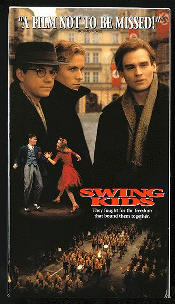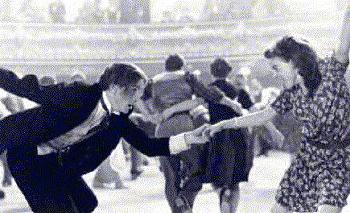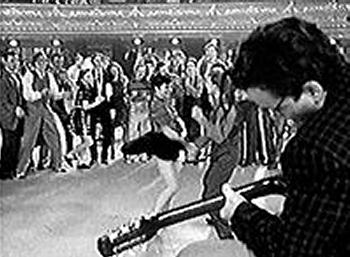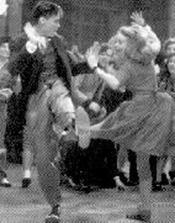Disney in the Classroom
Page 1 of 2
Disney in the Classroom
Swing Kids

In the late 1930's there was a new movement on the rise among the teenagers of Hamburg, Germany. It's followers refused to join the Nazi youth organization, the Hitler Jugend - known as the H.J. They wore their hair long and were obsessed by American movies, British fashion and swing music.
They called themselves SWING KIDS
Thus begins the tale of three teenagers who want to do the Lindy Hop instead of the goose step. Swing Kids premiered in 1993 as a Hollywood Pictures release. Critics tore into the movie calling it "shallow" and "disrespectful of The Holocaust". Nor was Swing Kids a commercial success. The movie did receive positive attention for its dance sequences. Some have even credited the sequences as an inspiration for the recent revival of interest in swing music and dancing.

It don't mean a thing if it
ain't got that swing
(c) Disney
Personally I don’t think the critics who blasted this movie spend much time with teenagers. They are a great deal like the kids in the movie. Going out and having a good time is often the center of their lives. The high school students in Swing Kids do this to escape the hatred, and the restrictions to their lives, inspired by the Nazis. High school students today often "party" to rebel against what they perceive to be restrictions or to try to escape from their problems. So Swing Kids reaches out to students where they are and then shows them that some problems (or evils) cannot be danced away. I have my sophomore students watch Swing Kids to demonstrate, and to discuss, the moral decisions Germans had to make during the Nazi era; to show why swing dancing was a popular way to escape the grim realities of life in Germany; (and in the United States) and to help students understand how a civilized people can be convinced to commit horrible acts that will ultimately lead to their own destruction.

Arvid swinging it out
(c) Disney
The main characters in Swing Kids, Peter, Thomas, and Arvid, are the best of friends and swing kids to the core. They spend all of their free time listening to swing music, dancing to it, or learning to play it. (Arvid is the group’s musician since he is crippled and cannot dance.) So intense is their commitment to swing music that they defy the Nazis’ ban on it, and risk arrest by dancing in, and by playing in, illegal swing clubs. (The Nazis banned swing and Jazz because the music was associated with very decadent Berlin nightclubs. Attacking the music made the Nazis appear moral. Banning the music also fit into the Nazis' racist agenda since most swing and Jazz was made by blacks and Jews.) Swing Kids does not present the boys' interest in swing music as a political protest. For Peter, Thomas, and Arvid Swing is just a way to escape the Nazis' attempts to control their lives.

Dancing the blues away
(c) Disney
Swing music, and the dancing inspired by it, is an excellent way to temporarily escape one’s problems. The music was serving this purpose in the United States, during the Great Depression, before it was imported to Germany. The celebrated dance sequences in Swing Kids do a wonderful job of recreating why this was so. One can understand why German teenagers would be so excited about the music as the Nazis placed more and more restrictions on their lives.
